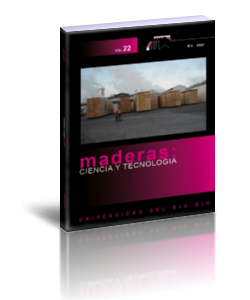Possibility of using lichen and mistletoe extracts as potential natural wood preservative
Keywords:
Decay test, retention, Usnea filipendula, Viscum album, wood protectionAbstract
Increasing environmental pressures on toxic chemical wood preservatives lead to the development of natural and environmentally friendly wood preservatives. In this study, using possibilities of lichen (Usnea filipendula) and leaves of mistletoe (Viscum album) as potential natural wood preservative were researched. Impregnation procedure was applied at four different concentration levels and with two different extraction methods (hot water and methanol). The concentration levels were arranged as 3%, 5%, 10%, 15% for hot water and as 3.75%, 6.25%, 12.5%, 18.75% for methanol. The treatment procedure has been applied according to the ASTM D 1413 (1988) standard test method. The fungal decay test has been done according to the EN 113 (1996) standard test method using a brown rot fungus, Coniophora puteana for both treated test and untreated control samples. The best results were obtained at the highest concentration level of the solutions. However, the weight losses in treated test specimen have not met the standard requirements. Nevertheless, it can be assumed that both natural extracts provide promising protection performance.
Downloads
References
ASTM D 1413. 1988. Standard Method of Testing Wood Presertives by Laboratory Soil-Block Cultures. D. 1413-76. In: Annual Book of ASTM Standards, Vol. 4.09 Wood, Philadelphia, PA, p. 239-245.
BAJRAKTARI, A.; NUNES, L.; KNAPIC, S.; PIMENTA, R.; PINTO, T.; DUARTE, S.; MIRANDA I.; PEREIRA, H. 2018. Chemical characterization, hardness and termite resistance of Quercus cerris heartwood from Kosovo. Maderas- Cienc Tecnol 20(3): 305-314. DOI: http://dx.doi.org/10.4067/S0718-221X2018005003101.
CANSARAN, D.; KAHYA, D.; YURDAKULOL, E.; ATAKOL, O. 2006. Identification and quantitation of usnic acid from the lichen Usnea species of Anatolia and antimicrobial activity. Zeitschrift für Naturforschung C 61(11-12): 773-776. DOI: https://doi.org/10.1515/znc-2006-11-1202.
COCCHIETTO, M.; SKERT, N.; NIMIS, P.; SAVA, G. 2002. A review on usnic acid, an interesting natural compound. Naturwissenschaften 89(4): 137-146. DOI: https://doi.org/10.1007/s00114-002-0305-3.
ERTÜRK, Ö.; KATI, H.; YAYLI, N.; DEMIRBAĞ, Z. 2004. Antimicrobial activity of Viscum album L. subsp. abietis (Wiesb). Turkish Journal of Biology 27(4): 255-258.
EUROPEAN COMMITTEE FOR STANDARDIZATION N-113. 1996. Wood Preservatives. Test Method for Determining the Protective Effectiveness Against Wood Destroying Basidiomycetes. Determination of the Toxic Values. Brussells, Belgium.
EVANS, P. 2003. Emerging technologies in wood protection. Forest Products Journal 53(1): 14-23.
FIDAH, A.; SALHI, N.; RAHOUTI, M.; KABOUCHI, B.; ZIANI, M.; ABERCHANE, M.; FAMIRI, A. 2016. Natural durability of Cedrus atlantica wood related to the bioactivity of its essential oil against wood decaying fungi. Maderas- Cienc Tecnol 18(4), 567-576. DOI: http://dx.doi.org/10.4067/S0718-221X2016005000049.
GOKTAS, O.; MAMMADOV, R.; DURU, M.E.; OZEN, E.; COLAK, A.M. 2007. Application of extracts from the poisonous plant, Nerium Oleander L., as a wood preservative. African Journal of Biotechnology 6(17): DOI: https://doi.org/10.5897/AJB2007.000-2307.
GONZÁLEZ-LAREDO, R.F.; ROSALES-CASTRO, M.; ROCHA-GUZMÁN, N.E.; GALLEGOS-INFANTE, J.A.; MORENO-JIMÉNEZ, M.R.; KARCHESY, J.J. 2015. Wood preservation using natural products. Madera y Bosques 21: 63-76.
HASSAN, B.; AHMED, S.; MEHMOOD, N.; MANKOWSKI, M.E.; MISBAH-UL-HAQ, M. 2019. Toxicity potential of heartwood extractives from two mulberry species against Heterotermes indicola. Maderas- Cienc Tecnol 21(2): 153-162.
DOI: http://dx.doi.org/10.4067/S0718-221X2019005000203.
KADIR, R. 2017. Toxic effects of three selected Malaysian timbers plant extracts against subterranean termites. Maderas- Cienc Tecnol 19(4):417-432. DOI: http://dx.doi.org/10.4067/S0718-221X2017005000201.
KARTAL, S.N.; HWANG, W.-J.; IMAMURA, Y.; SEKINE, Y. 2006. Effect of essential oil compounds and plant extracts on decay and termite resistance of wood. Holz als Roh- und Werkstoff 64(6): 455-461. DOI: https://doi.org/10.1007/s00107-006-0098-8.
MAO, L.; HENDERSON, G. 2007. Antifeedant Activity and Acute and Residual Toxicity of Alkaloids from Sophora flavescens (Leguminosae) Against Formosan Subterranean Termites (Isoptera: Rhinotermitidae). Journal of Economic Entomology 100(3): 866-870. DOI: https://doi.org/10.1603/0022-0493(2007)100[866:aaaaar]2.0.co;2.
NAKAYAMA, F.; VINYARD, S.; CHOW, P.; BAJWA, D.; YOUNGQUIST, J.; MUEHL, J.; KRZYSIK, A. 2001. Guayule as a wood preservative. Industrial Crops and Products 14(2): 105-111. DOI: https://doi.org/10.1016/S0926-6690(00)00093-5.
OCHOCKA, J.R.; PIOTROWSKI, A. 2002. Biologically active compounds from European mistletoe (Viscum album L.). Canadian Journal of Plant Pathology 24(1): 21-28. DOI: https://doi.org/10.1080/07060660109506966.
ONUORAH, E.O. 2000. The wood preservative potentials of heartwood extracts of Milicia excelsa and Erythrophleum suaveolens. Bioresource Technology 75(2): 171-173. DOI: https://doi.org/10.1016/S0960-8524(99)00165-0.
SEN, S.; TASCIOGLU, C.; TIRAK, K. 2009. Fixation, leachability, and decay resistance of wood treated with some commercial extracts and wood preservative salts. International Biodeterioration & Biodegradation 63(2): 135-141. DOI: https://doi.org/10.1016/j.ibiod.2008.07.007.
SINGH, T.; SINGH, A.P. 2012. A review on natural products as wood protectant. Wood Science and Technology 46(5): 851-870. DOI: https://doi.org/10.1007/s00226-011-0448-5.
TASCIOGLU, C.; YALCIN, M.; DE TROYA, T.; SIVRIKAYA, H. 2012. Termiticidal properties of some wood and bark extracts used as wood preservatives. BioResources 7(3): 2960-2969.
TASCIOGLU, C.; YALCIN, M.; SEN, S.; AKCAY, C. 2013. Antifungal properties of some plant extracts used as wood preservatives. International Biodeterioration & Biodegradation 85: 23-28. DOI: https://doi.org/10.1016/j.ibiod.2013.06.004.
YANG, D.-Q. 2009. Potential utilization of plant and fungal extracts for wood protection. Forest Products Journal 59(4): 97.

































